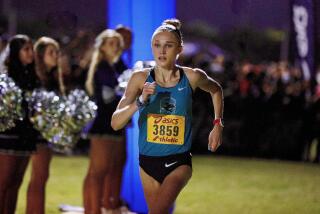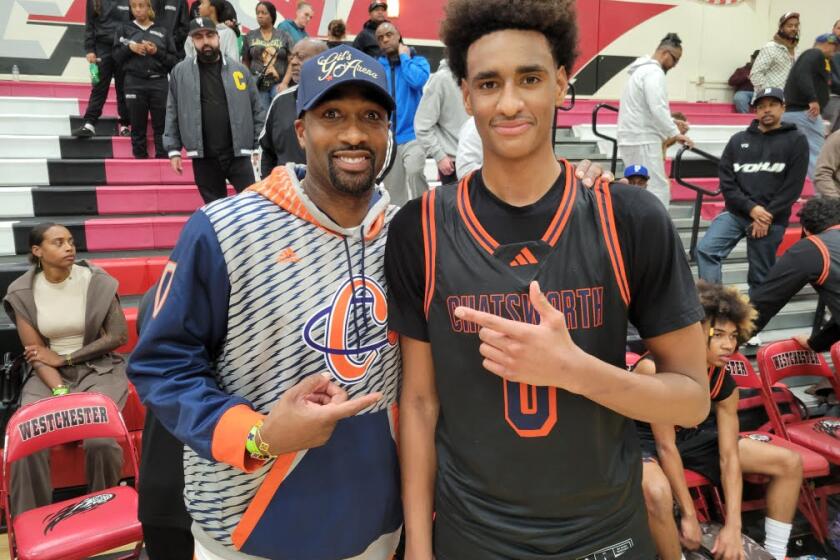RUNNING HARD
SANTA ANA — Cross-country is a sport with a heritage rooted in the English countryside. And though many high school runners still enjoy dusty trails of rolling regional parks and invigorating climbs through hills, others are forced to take a different path.
Take, for instance, Orange County’s top-ranked boys’ cross-country team, which does almost all its training on the asphalt and concrete around Santa Ana High School.
“Our hill work,” jokes Santa Ana Coach Darel Newman, “is on speed bumps.”
But the flat, urban training grounds certainly haven’t hindered the Saints, who have been the county’s most consistently strong team in the 1990s. In four of the past five years, Santa Ana has advanced to the state meet and appears poised to do it again this season.
It might seem like an unlikely success story. After all, there are significant obstacles to athletic excellence at Santa Ana.
The students come mostly from immigrant families on the low end of the socioeconomic scale. Priorities other than participation in sports--putting food on the table, for one--usually take precedence.
But you don’t have to spend much time with the Saints’ cross-country team to discover there’s no secret to its success. It’s a simple recipe: Take talented athletes, give them support and guidance, and watch them rise to the occasion.
*
There’s little to indicate the 25 boys warming up easily on the Santa Ana track are the building blocks of a cross-country dynasty. In their red T-shirts and worn running shoes, the group could easily pass for a garden variety physical education class.
But take a closer look:
Powerfully built Alfonso Leon finished eighth in the state Division II race in his first season of high school cross-country last year.
Wiry Juan Salgado runs stride for stride with Leon in most races. They are among the top runners in the county.
The pack behind them--Luis Perez, Omar Mateo, Jorge Pena, Miguel Bolanos, Jose Cholula and Miguel Ortiz, not necessarily in that order--isn’t too far back. Depth is a strength of this team. It’s still early in the season, but the Saints expect to soon have seven runners break 16 minutes for three miles.
Today’s workout is an easy one, explains Roger Nava, the assistant in charge of the boys’ team. The runners will run about five miles round trip on the streets south of campus.
The route is about the only way to go without encountering heavy traffic and traffic signals that would interrupt their steady pace. Anyone who has run in the city knows there are hazards. Santa Ana runners manage to avoid them fairly well, but over the years runners have been chased by dogs, hit by cars and even had someone take pot shots at them with a BB gun.
Current Saints, however, don’t have any horror stories. About only problems they face on runs near campus are gang members who occasionally taunt them.
“They tell us we’re jerks,” Leon said. “That we are wasting our time and should be at home kicking back and watching TV.”
Leon and his teammates easily laugh off that type of reaction, especially because it’s the exception. Most of the people they see in the well-groomed neighborhoods cheer them on.
One family has even set up a water stop, complete with a sign--”SAHS X-Country Water Station”--taped to a palm tree, in the front yard along the team’s regular route.
On the whole it’s a supportive environment, even though Nava wouldn’t mind more varied terrain. “It would be nice to step out of your high school and see a couple of hills,” he said, “but, you know, we can live with it.”
*
Actually, the Saints are doing much more than that. They are thriving and that’s, in large part, because of Nava’s guidance. He was a standout runner for Santa Ana, leading the Saints to the first league cross-country championship in school history, the 1988 Century League title.
After two years at Rancho Santiago College, Nava rejoined the Saints as a walk-on assistant in 1991. The next season he took over the boys’ program and the Saints finished eighth in the state Division I meet.
In 1993 the team won the Orange County Championships and the section Division I-AA title, before finishing second in the state to Thousand Oaks, the top-ranked team in the nation.
Nava, 26, has done well to maintain that momentum.
“He brings his past experience as a competitor,” said Santa Ana Athletic Director Frank Alvarado, “and very strong technical knowledge of running. And he’s worked very hard to make himself a good coach.
“Finally, he brings a great enthusiasm and love of the sport.”
Of course, Nava stepped into a program with strong foundations. It hasn’t always been that way. Alvarado ran for a Santa Ana team that qualified for the postseason in 1968, but in 1980 when he came back as an assistant coach, there were only about 10 runners on the boys’ team.
By the mid-1980s, however, the Saints were gaining momentum under the direction of then-coach Jeff Davis. In 1986, when Nava was a sophomore, the team qualified for the section preliminaries for the first time in more than a decade.
Now, Santa Ana’s program runs smoothly. Newman, a longtime Santa Ana coach and physical education teacher, handles the administrative details and paperwork. Imelda Nava, Roger’s older sister and another former Saint runner, coaches the girls’ team.
It helps that support from the school district is strong for cross-country, Alvarado said. The district established cross-country teams at intermediate schools in the early 1980s, which means there is a steady stream of athletes already familiar with the sport when they reach high school.
This has also helped the running programs at Saddleback, Century and Santa Ana Valley, which all have reached a section final during the ‘90s. “It’s not just Santa Ana High,” Alvarado said. “You have to look at all the Santa Ana high schools. All of us have had a great deal of success.”
So why has Santa Ana been the most successful?
“The bottom line is you have to have talent and we’ve had a number of classes with a great amount of talent,” Alvarado said. “There’s an old axiom that success breeds success and that’s what has happened. We have built a reputation as a powerhouse in cross-country and kids want to come out for our team.”
Once they come into the fold, runners are given the tools and the help to develop. If money is a problem, the program helps with shoes or even the insurance fee required to participate in athletics.
The team takes an annual end-of-summer trip to Lake Gregory in the San Gabriel Mountains. The cost for the each runner is $5; a $2,000 donation from D&F; Industries in Orange helps pay for the trip.
Training at altitude--about 5,000 feet--and on hills makes it a productive week, but more it’s more important as a way to build team camaraderie by spending 24 hours a day together.
“I tell them, ‘I hope you are friends right now,’ ” Nava said. “ ‘And I hope you’ll be friends after high school.’ That’s one of the best things you can get out of sports.”
*
At a recent Saturday invitational, Woodbridge High School was teeming with nearly 5,000 cross-country runners from 136 teams. Among the estimated 3,000 spectators lining the course or milling about on the infield of the track were scores of parents.
None were parents of Santa Ana High runners.
That’s not unusual, Alvarado said. Parents of Santa Ana athletes are more apt to turn out to support events on campus, he said, near their neighborhood.
It’s not that they don’t care, said Armando Torres, who coached three current Santa Ana varsity runners at Willard Intermediate. “They are so busy trying to bring income into the family,” he said, “so they can feed them and put shelter over their heads.”
Typically, students are expected to help out by working, especially during the summer. For instance, Santa Ana junior Omar Mateo worked from 4 p.m. to 2 a.m. in a bakery this summer and couldn’t train with his teammates.
Now he’s playing catch-up, trying to get in shape during the season.
But it could be worse. In the past Saint runners have missed meets because of work.
“Oftentimes the kids have other priorities that supersede athletics and that’s the bottom line,” Alvarado said. “It’s very difficult. We’ve been lucky the last few years, but there have been times when kids couldn’t run Saturday meets because they had to work.”
On this Saturday, everyone is present and listening intently to Nava’s instructions before the Division I junior race.
The start is the key, he tells them, don’t get caught behind the pack. “Stick out your elbows, give yourself some room,” Nava says, “because if you don’t, someone is going to knock you down.
“Remember how hard we worked all summer,” he continues. “That’ll give you confidence.
“If something hurts, I don’t care.”
There’s no getting around pain in cross-country. As Salgado, a junior and one of the Saints’ captains, says: “We know what’s going to happen in the race and it’s not going to be a nice thing.”
Leon and Salgado were grimacing after their race. They finished third and fourth, leading five Saints in the top 12, but believed they should have run faster.
Still it’s early in a long season and the Saints hadn’t yet started speed work. “There’s nothing to worry about,” Salgado said. “We know there are bigger meets in front of us.”
(BEGIN TEXT OF INFOBOX / INFOGRAPHIC)
Decade of Success
A look at the recent achievements of the boys’ cross-country team at Santa Ana High:
* 1986--Qualified for Southern Section preliminaries
* 1987--Qualified for section preliminaries
* 1988--Century League champions, advanced to section finals
* 1989--Century League champions, advanced to section finals
* 1990--Advanced to section preliminaries
* 1991--Sunset League champions, advanced to section preliminaries
* 1992--Sunset League champions, finished eighth in state Division I
* 1993--Southern Section Division I-AA, Sunset League and Orange County champions; second in state Division I
* 1994--Won Golden West League title
* 1995--Section Division I-A champions, finished 10th in state
* 1996--Third in section and state Division II
More to Read
Get our high school sports newsletter
Prep Rally is devoted to the SoCal high school sports experience, bringing you scores, stories and a behind-the-scenes look at what makes prep sports so popular.
You may occasionally receive promotional content from the Los Angeles Times.






